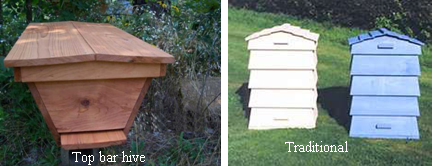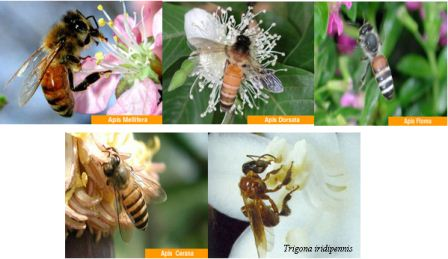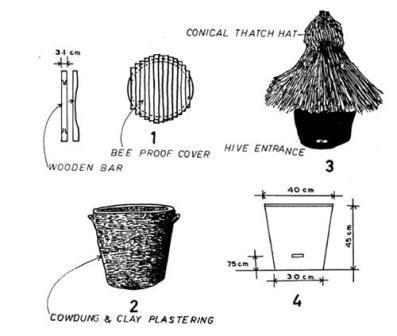About Bee Keeping
About Bee Keeping
What is apiculture?
- Collection of honey from the forests has been in existence for a long time.
- Honey bees convert nectar of flowers into honey and store them in the combs of the hive and the growing market potential for honey and its products has resulted in bee keeping emerging as a viable enterprise.
- Honey and wax are the two economically important products of bee keeping.
- Bee keeping is an agro based enterprise for additional income generation
Advantages of beekeeping as an income generation activity
- Bee keeping requires less time, money and infrastructure investments
- Honey and beeswax can be produced from an area of little agricultural value
- The Honey bee does not compete for resources with any other agricultural enterprise.
- Beekeeping has positive ecological consequences. Bees play an important role in the pollination of many flowering plants, thus increasing the yield of certain crops such as sunflower and various fruits.
- Honey is a delicious and highly nutritious food. By the traditional method of honey hunting many wild colonies of bees are destroyed. This can be prevented by raising bees in boxes and producing honey at home.
- Beekeeping can be initiated by individuals or groups
- The market potential for honey and wax is high
Production process
Honey bees can be raised in boxes at the farm or home.Equipment requirements for bee keeping

- Hive: It is a simple long box covered with a number of slats on top. The rough measurements of the box should be around 100 cm of length, 45 cm of width and 25 cm in height. The box should be 2 cm thick and the hive must be glued and screwed together with entrance holes of 1 cm wide. The slats (top bars) must be as long as the hive is wide in order to fit across and the thickness of about 1.5 cm is sufficient to support a heavy honey comb. The width of 3.3 cm needs to be given to give the bees the natural spacing they need to easily build one comb to each separate top bar.
- Smoker : It is the second important piece of equipment. This can be made from a small tin .We use the smoker to protect ourselves from bee stings and to control the bees.
- Cloth: to protect our eyes and nose from stings at the time of work near the apiary.
- Knife: It is used to loosen the top bars and to cut of the honey bars.
- Feather: To sweep the bees from the comb.
- Queen Excluder
- Match box
Species of honey bees

- Rock bee (Apis dorsata): They are good honey gathers with an average yield of 50-80 kg per colony.
- Little bee (Apis florea): They are poor honey yielders and yield about 200-900 g of honey per colony.
- Indian bee (Apis cerana indica): They yield an average honey yield of 6-8 kg per colony per year.
- European bee [Italian bee] (Apis mellifera): The average production per colony is 25-40 kg.
- Stingless bee (Trigona iridipennis): They have poorly developed stings and are available in Kerala. They are efficient pollinators. They yield 300-400 g of honey per year.
Establishment of hives
- The apiary must be located in well-drained open area, preferably near orchards, with profuse source of nectar, pollen and water.
- Protection from sunlight is important in order to maintain an optimum temperature in the hive.
- Ant wells are fixed around the hive stand. The colonies must be directed towards east, with slight changes in the directions of the bee box as a protection from rain and sun.
- Keep the colonies away from the reach of cattle, other animal, busy roads and streetlights.
Establishing a bee colony
- To establish a bee colony, bees can be obtained by transferring a wild nesting colony to a hive or attract a passing swarm of bees to occupy it.
- Before putting a swarm or even a colony in a prepared hive, it would be beneficial to make the hive smell familiar by rubbing old brown comb pieces or some bee wax. If possible, the Queen bee can be captured from a natural swarm and placed under a hive to attract the other bees.
- Feed the hived swarm for a few weeks by diluting a half cup of white sugar in half a cup of hot water as this will also help in building the comb along with the bars rapidly.
- Avoid over crowding
Management of colonies
- Inspect the beehives at least once in a week during the honey-flow seasons preferably during the morning hours.
- Clean the hive in the following sequence, the roof, super/supers, brood chambers and floorboard.
- Observe the colonies regularly for the presence of healthy queen, brood development, storage of honey and pollen, presence of queen cells, bee strength and growth of drones.
- Look for the infestation by any of the following bee enemies.
- Wax moth (Galleria mellonella): Remove all the larvae and silken webbings from the combs, corners and crevices of bee box.
- Wax beetles (Platybolium sp.): Collect and destroy the adult beetles.
- Mites: Clean the frame and floorboard with cotton swabs moistened with freshly made potassium permanganate solution. Repeat until no mites are seen on the floorboard.
- Management during lean season
- Remove the supers and arrange the available healthy broods compactly in the brood chamber.
- Provide division board, if necessary.
- Destroy queen cells and drone cells, if noted.
- Provide sugar syrup (1:1) @ 200 g sugar per colony per week for Indian bees.
- Feed all the colonies in the apiary at the same time to avoid robbing.
- Management during honey flow season
- Keep the colony in sufficient strength before honey-flow season.
- Provide maximum space between the first super and the brood chamber and not above the first super.
- Place queen excluder sheets in between brood and super chamber to confine the queen to brood chamber.
- Examine the colony once in a week and frames full of honey should be removed to the sides of the super. The frames, which are three-fourth filled with honey or pollen and one-fourth with sealed brood should be taken out of brood chamber and in its place empty combs or frames with foundation is added.
- The combs, which are completely sealed, or two-third capped may be taken out for extraction of honey and returned to supers after honey extraction.
Harvesting of honey
- Harvest the honey by smoking the bees off the parts which needs to be harvested and cut the combs carefully.
- Harvests are normally possible during and shortly after the two main flowering seasons, namely October/November and February-June .
- A ripe comb is light in colour and filled with honey. More than half of the honey cells on both the sides are sealed with wax.
Source : Kerala Agricultural University
Greek basket hive

Greek basket hive is a traditional technology using local material useful for apiculture.
Greek basket construction
- The basket has a wide top and a narrow base.
- The top is covered with parallel wooden bars 1.25 inches wide, placed close together in such a manner so as to form a bee-proof cover. Each bar is convex length wise (on the underside), with a clearance of about one inch. The convexing must come in the middle of the bar. Both ends should be left flat for about 2-3 inches to prevent the bees from passing through the ends where bars, which are larger than the circumference of the basket, rest on the rim of the basket
- Along the length, in the middle of every bar, a fine piece of comb is fixed underneath, with melted bee wax to guide the bees to build straight combs.
- The basket is plastered inside and out with a mixture of two parts of fresh cow dung to one part of clay
- When the plaster is dry, the bars are placed on top of the basket which is then covered with a conical hat made of thatch to protect from sun and rain.
- It is vital to have the hive entrance at least three inches from the bottom so that if a comb does fall, the entrance will not be blocked
- When the honey is ripe and the honey-flow is over, the combs are cut from the bars. However, a fine strip of comb, no more than quarter inch, is left on each bar to guide the bees to build straight, new combs again.
Source: Centre for Science for Villages, Wardha, Maharashtra
Related resources
Last Modified : 8/14/2020
© C–DAC.All content appearing on the vikaspedia portal is through collaborative effort of vikaspedia and its partners.We encourage you to use and share the content in a respectful and fair manner. Please leave all source links intact and adhere to applicable copyright and intellectual property guidelines and laws.
RELATED ITEMS
Advisory on Good Beekeeping Practices (GBPs)
This topic provides information about Advisory on ...
Post-Harvest Handling Protocol for Honey-Broad Guidelines for use of FPOs
Provides information about Post-Harvest Handling P...
Zero tillage Zero worries
This topic provides information about Zero tillage...
Wonders of Bees
This topic provides information about Wonders of B...
RELATED LANGUAGES
